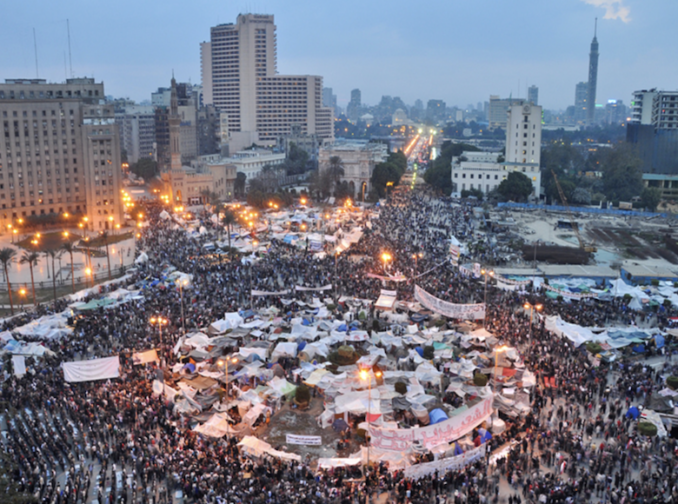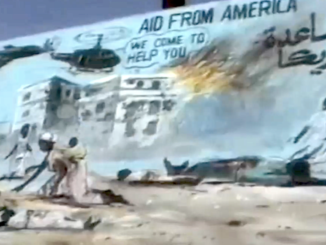
Tahrir Square – February 9, 2011,
Honor The King – Licence CC BY-SA 2.0
Tunisia 2010
The plan for regime change borrowed the model used to remove the Shah of Iran and the return of Imam Khomeini. On 17 December 2010, street vendor Mohamed Bouazizi set himself on fire after police seized his wheelbarrow. It became the catalyst for the Jasmine Revolution as the Anglo-American Alliance (AAA) activated the Brotherhood to seize the opportunity. The Brotherhood circulated false information the man was an unemployed university student who’d been slapped in the face by a female police officer. Immediately the Cocaine Importation Agency’s fake NGO, the National Endowment for Democracy (NED) paid the dead man’s family not to reveal the truth and began fomenting a national revolt. Demonstrations against unemployment and police violence followed. President Zine El-Abidine Ben Ali whose pockets were controlled by Washington was asked to leave (he did) and Meddling Internationally 6 organised the return of Rached Ghannouchi to replace Ali.
Ghannouchi had created a local chapter branch of the Brotherhood and in 1987 attempted a coup d’état. Arrested and imprisoned several times, he eventually took exile in Sudan (with support from Hassan al-Turabi, then in Turkey where he was supported by Erdogan. He eventually obtained to no one’s surprise political asylum in Londonistan, where he lived in Finsbury (close to the Mosque) with his two wives and children. He also undertook coaching and development of a political model from Meddling Internationally 6. Meddling Internationally 6 rebranded and improved the “image” of his party, the Movement for Islamic Tendency (“Ennahda”). To soothe the Tunisian population’s fear of the Brotherhood, NED called on its extreme left puppets to offer moral sanction. Out of nowhere, Ghannouchi claimed the Brotherhood had changed and had become democrats. He was elected President of Tunisia.
Despite receiving support from part of the Tunisian population when he returned, his party quickly sank into the minority. Before being forced from power by Tunisian secularist parties in 2014, Ghannouchi forced a vote on the tax code which was aimed in the long term at ruining the secular group in response to their blocking of the Brotherhood/jihadist approach supporting Sharia. Despite stepping down, in May 2016, the tenth Ennahda “congress” was organised by Meddling Internationally 6’s created Innovative Communications and Strategies, fronted by Oxford University and the activating of the info war. While the speakers gave assurances the party had become “civil”, with a separation of political and religious activities. But this had zero connection with secularism, it simply required a division of labour between members, who must refrain from being both an elected official and an imam at the same time.
Egypt, The Lotus Revolution
Just one week after Tunisia’s President Ben Ali had fled, on 25th January 2011, an Egyptian national holiday was transformed into a demonstration against the authorities. Protests were supervised by the US team traditionally used for colour revolutions – Serbs trained by Gene Sharp (a NATO theorist specialised in non-violent regime change, in other words without recourse to war) and the men from Cocaine Importation Agency’s NED. Demonstrators were mobilised by the Brotherhood, who enjoyed circa 15%-20% support nationally and also by Kifaya (“That’s Enough”), created by Gene Sharp.
The protests that had been initiated mainly in Cairo, on Tahrir Square (and seven other major cities) by younger internet-savvy agitators via Farcebook, and were described by international media interviewers (aka the House of Saville, Sly News etc.) as the ‘opposition’ seeking ‘political reform’ and ‘democracy’. It was different from the approach in Tunisia.
Following orders, the Brotherhood used weapons from the start. On Tahrir Square, they moved the wounded to the mosque, which was fully equipped with a medical theatre to provide aid. Arab TV channels, primarily Al Jazz and Saudi’s al-Arabyia called for the overthrow of the regime, carrying live broadcasts providing strategic information. Proving a permanent screw loose in the brain, the Septics called on the e-Director of the International Atomic Energy Agency (IAEA), Nobel Peace Prize winner and President of the National Association for Change, Mohamed el-Baradei. He had been ‘honoured’ by the Septics for controlling Hans Blix who, when in the UN denounced the lies the Bush administration had used to justify the Iraq war. For over a year, el-Baradei presided over a coalition created on the model of the Damascus Declaration – with lukewarm, non-confrontational text, signatories from all sides, including the Brotherhood, whose own programme was the complete opposite to that of the platform.
Finally, the Brotherhood was the first Egyptian organisation to call for the overthrow of the regime. All TV stations of NATO states predicted the flight of Hosni Mubarak. Obama’s special envoy, Ambassador Frank Wisner (father-in-law to Agent Sarkozy), initially supported Mubarak, then withdrew and hid for two weeks. Wisner then pressed Mubarak to resign. After two further weeks of rioting and demonstrations, Mubarak resigned. Proving the Septics had another screw loose in the brain, now they wanted to change the constitution before putting the Brotherhood in power. Power was therefore retained, temporarily, in the hands of the army. Marshall Mohammed Hussein Tantawi presided over the military committee administering ‘current affairs’. He nominated a Commission of seven members, two of whom were from “the Brotherhood”. One of them, Judge Tariq Al-Bishri, presided over the work of the commission.
Not happy, the Brotherhood continued to hold demonstrations every Friday after mosque prayers and continued lynching Coptic Christians with the police turning a ‘blind eye’. The Brotherhood, who ‘dominated’ the new interim Parliament/Constituent Assembly, was of the opinion the new constitution, drawn up specifically to expedite its formal election, did little more than reiterate an amended old text, although it had been approved by 77% of the population in a referendum. It designated a Constituent Assembly of 100 members, including 60 Brotherhood members.
The Brotherhood stressed that ‘young democrats’ could undermine the power of the Army. Its presidential election campaign called on the regeneration of the country by the Quran. Yusaf al-Qaradawi preached it was more important to fight homosexuals and re-instate the faith than to fight Israel for the recognition of Palestinian peoples’ rights. The Sunni population boycotted the election, the Brotherhood prevented the election being held in Christian villages and towns, so some 600,000 people were unable to vote. However, the election results favoured General Ahmed Shafik, Mubarak’s ex-PM, who’d won by a small margin of 30,000 votes. The Brotherhood weren’t happy, so they threatened the members of the Electoral Commission and their families. Thirteen days later, it decided to proclaim victory for Brother Mohamed Morsi. The Western ‘international’ community praised the democratic character of the election.
Apart from being a member of the Brotherhood, Morsi was a qualified engineer with a PhD in materials science from the University of Southern California in 1982, with his dissertation on aluminium oxide. He also worked for NASA, had US nationality and secret defence security clearance in the Pentagon. Once he’d been placed in political power (with orders to follow), he began work to rehabilitate and favour his own clan, and to reinforce the bonds with Israel. On the anniversary of Sadat’s execution, he warmly received the assassins at the Presidential Palace. He nominated Adel Mohammed al-Khayat, one of the leaders of the Gamaa Al-Islamiya (the group responsible for the November 1997 Luxor massacre) as Governor of Luxor.
Morsi persecuted the ‘democrats’ who demonstrated against certain aspects of Mubarak’s politics (but not his resignation). He supported a vast campaign of pogroms by the Brotherhood against Christians and covered up the abuses (burning of churches, lynchings etc). He privatised major businesses and announced the possible sale of the Suez Canal to Qatar, which was then sponsoring the Brotherhood. From the Presidential Palace, he phoned Ayman al-Zawahiri head of AQ daily.
Excepting the Brotherhood, unanimous opposition to Morsi rose across all political parties, including Salafists, and demonstrated against him. Thirty-three million people took to the streets calling on the Army to return power back to the people. Taking no notice of the protests, Morsi ordered the Army to attack Syria in order to come to the assistance of the Syrian ‘Brotherhood’. This proved to be the straw that broke the camel’s (or in this case) Morsi’s back.
On 3rd July 2013, at the hour that Washington’s offices closed for the long Independence Day weekend, the Army carried out the coup d’état. Morsi was imprisoned, while the streets became a battlefield – the Brotherhood and their families on one side, the law enforcement agencies and the majority of the population on the other. The House of Saville tried to put a brave spin on the coup.
With other ‘Arab’ Spring agendas enacted in Bahrain, Libya, Syria, Sudan and Yemen plus other revolts in Algeria, Jordan, Morocco, and Oman, the next piece will cover available details of the Brotherhood’s string pullers.
© AW Kamau 2023



